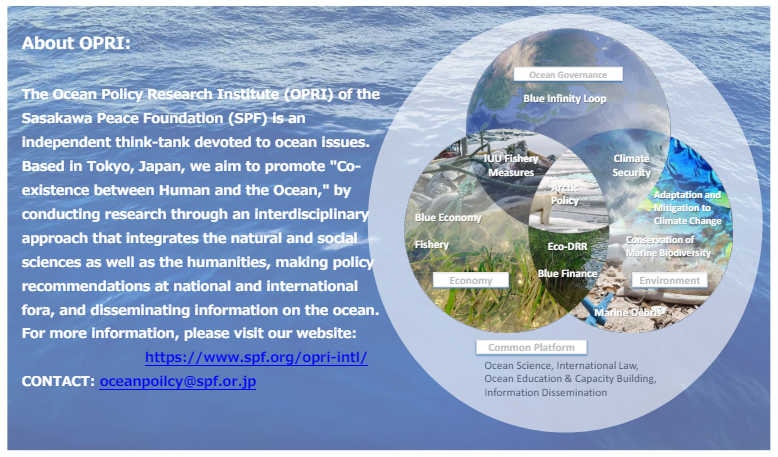Proposal / Research
Deepening the Ocean - in the Post-2020 Global Biodiversity Framework
The Ocean is under threat
The Aichi targets were achieved only partially, and it calls for an ambitious Post2020 Global Biodiversity Framework to be agreed in Kunming, China in 2022. There is little time left to restore biodiversity around the globe and to seek balance between conservation and sustainable use. Marine biodiversity is under threat globally, and relevant Goals and Targets need to be strongly reflected in the new Framework, including 30x30, sustainable fisheries and aquaculture, zero plastic wastes, conserving EBSAs, and promoting blue carbon and its co-benefits.
The Aichi targets were achieved only partially, and it calls for an ambitious Post2020 Global Biodiversity Framework to be agreed in Kunming, China in 2022. There is little time left to restore biodiversity around the globe and to seek balance between conservation and sustainable use. Marine biodiversity is under threat globally, and relevant Goals and Targets need to be strongly reflected in the new Framework, including 30x30, sustainable fisheries and aquaculture, zero plastic wastes, conserving EBSAs, and promoting blue carbon and its co-benefits.
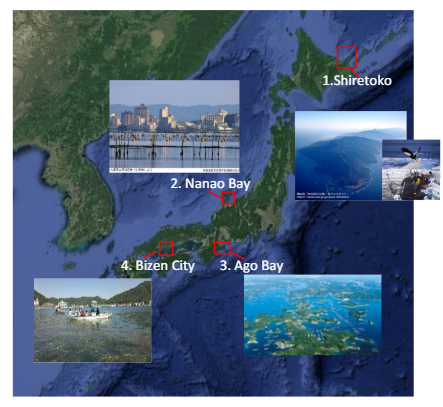
Four sites were selected in this paper, where “Satoumi” activities were implemented in the pursuit of sustainable integrated coastal management (ICM), namely: 1. Shiretoko World Natural Heritage Area, 2. Nanao Bay in Ishikawa Prefecture, 3. Ago Bay in Shima City, and 4. Hinase Area in Bizen City. Satoumi is “a sea where high productivity and conservation of biodiversity are achieved through human intervention in harmony with natural ecosystems”. Integrated Management of the Coastal Zone based on the Satoumi approach has been positioned in the Basic Plan on Ocean Policy and the National Biodiversity Strategy of Japan. Unique Satoumi efforts are made in local coastal areas in Japan to ultimately aim at “Living in harmony with nature” in a local context. This brief aims to provide lessons from these sites in relation to reflecting marine and ocean elements in a Post-2020 Global Biodiversity Framework.
1. Effective Multi-sectoral Coordination in SHIRETOKO World Natural Heritage Area
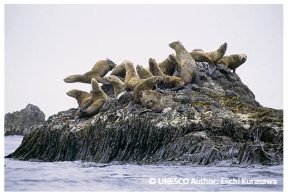
The Shiretoko Peninsula is situated at the northernmost part of Japan and the lowest latitude of the world’s seasonal sea ice zone in the Northern Hemisphere. Its high primary productivity, including the blooming of phytoplankton due to vertical mixing after the melting of sea ice, supports a wide variety of species such as fish, marine mammals, and seabirds. Fishing and tourism have long been major industries in Shiretoko. In the 1990s, local fishers in the area started voluntary activities to sustainably use fishery resources such as the establishment of nofishing zones, and in 2005, the area was inscribed on the World Heritage List for its rich biodiversity and unique marine and terrestrial ecosystems.
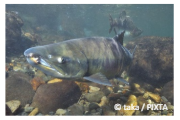
A distinctive feature of the Satoumi activities in Shiretoko is the establishment of a comprehensive management system that integrates the national government, local governments, businesses and fishers within the framework of World Heritage management. A new coordination system among departments and ministries has been established. A feature of marine area management is the adoption of the "Shiretoko approach", which places no restrictions on the voluntary management already carried out by fishers, and coordinates the laws and regulations related to marine ecosystem conservation and fishing, voluntary management by fishers, and voluntary rules for marine tourism under the management plan. The "Multiple Use Integrated Marine Management Plan" specific to marine areas has been developed through discussions in the Marine Working Group under the Scientific Council.
LESSONS LEARNED
- In response to a decrease in the catch of walleye pollock, an important fishery species in the Shiretoko area, and an increase in the amount of damage to the fishery by Steller's sea lions, various efforts were made, such as adding a no-take zone for walleye pollock, adding value to marine products by branding, utilizing yellowtail and other species that have been caught in recent years, and maintaining fishery production value by combining a variety of fish species. Fishers now tend to prefer quality and added-value vs. quantity.
- In response to scientific advice, modifications of river structures have led to an increase in spawning beds for salmon; also, with regard to marine recreation, a population of spectacled guillemot, which it was feared would be affected by cruise ships, has been stable in recent years. The Satoumi approach encompasses human interventions through scientific monitoring, continuous learning and adaptive management.
- Global warming has had an impact on ecosystems, including a reduction in the sea ice extent of the Sea of Okhotsk (down 10% in the last 30 years), which affects the marine ecosystem in Shiretoko, and changes in the fish fauna. Whole-of society adaptation measures are needed.
2. Landscape and Seascape Approach Practiced to Sustain Local Livelihoods in NOTO
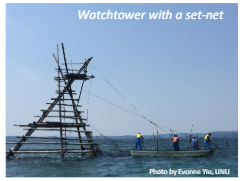
Nanao Bay, located on the eastern side of the Noto Peninsula in Ishikawa Prefecture, is one of the component parts of the Globally Important Agricultural Heritage System (GIAHS) which was designated for the first time in Japan in 2011, and is also designated as the Noto Peninsula Quasi-National Park. Fisheries such as sea cucumbers, mozuku seaweed, and shellfish are active in Nanao Bay (North Bay and West Bay), and oyster farming is also practiced.
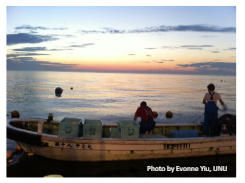
Since the late 1980s, Nanao Bay has been experiencing a decline in fish catches and the degradation of the marine environment, which called for comprehensive coastal management of land and sea areas. Following the launch of the Nanao Bay Satoumi Creation Project in 2008 as a model project of the Ministry of the Environment, a number of activities were carried out, including water pollution reduction, such as the upgrading of wastewater treatment facilities, public awareness and small-scale restoration of eelgrass as well as the creation of diverse environments through the placing of stones around artificial concrete revetments. In addition, the traditional fishing method of “Set-net” mullet fishing (using a watchtower) in Anamizu Town was revived. Dolphin watching has also become popular in recent years.
The water quality in the marine area has not shown significant improvement, but the water quality of the Misogigawa River (flowing into the South Nanao Bay), which was considered to be the most seriously polluted, has shown signs of improvement in recent years. As for the fishery resources, there is no clear trend of recovery, but the shellfish fishery of Bloody clam and Japanese cockle, which were temporarily banned from being fished, has been operated continuously in recent years due to the effect of resource management. The rate of increase in water temperature in Nanao Bay is estimated to be 1.89°C per 100 years, and the effects of global warming have been recognized as a new threat in recent years. There are concerns about the adverse effects on oyster farming due to rising sea water temperature and formation of hypoxia.
The water quality in the marine area has not shown significant improvement, but the water quality of the Misogigawa River (flowing into the South Nanao Bay), which was considered to be the most seriously polluted, has shown signs of improvement in recent years. As for the fishery resources, there is no clear trend of recovery, but the shellfish fishery of Bloody clam and Japanese cockle, which were temporarily banned from being fished, has been operated continuously in recent years due to the effect of resource management. The rate of increase in water temperature in Nanao Bay is estimated to be 1.89°C per 100 years, and the effects of global warming have been recognized as a new threat in recent years. There are concerns about the adverse effects on oyster farming due to rising sea water temperature and formation of hypoxia.
LESSONS LEARNED
- Recreation of diverse habitats in concrete disaster prevention facilities were observed. As a result of putting natural stones along the artificial vertical seawall and regenerating a diverse environment on the coast, the habitat of sea cucumbers was confirmed.
- Since 2001, a family of southern bottlenose dolphins has inhabited the area, and dolphin watching has become popular. Rules for the coexistence of fishery operations and tourism were formulated, and there have been no reports of conflicts between fishers and tourism operators in recent years.
- With recognition as World Agricultural Heritage sites, the traditional mullet waiting cages were rebuilt and traditional fishing was resumed. This is a sustainable fishing method that places importance on the environment, rather than efficiency per se.
3. Satoumi Promoted by City Government Based on Solid Science in AGO BAY
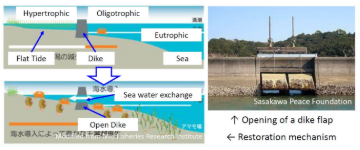
Ago Bay is located in the southern part of the Shima Peninsula in Shima City, Mie Prefecture, and forms the center of the Ise-Shima National Park. It has a complicated rias coastline, and has been traditionally known for high productivity, providing the sacred offerings for Ise Shrine since ancient times. Cultivation of pearls is actively practiced and has supported the economy of Shima City and the surrounding municipalities. However, there has been a decline in the natural purification capacity of the sea due to land use change and loss of tidal flats, which provide rich biodiversity and habitats for rare aquatic organisms and birds. In addition, the inflow of domestic wastewater from the surrounding areas, environmental degradation due to overcrowded aquaculture, and the occurrence of red tides are major issues.
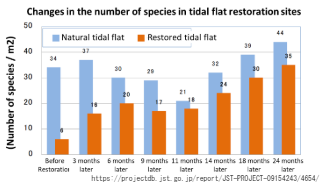
In order to cope with the impact on the fishery industry, pearl cultivators had taken the initiative in launching voluntarily Satoumi activities, such as artificial tidal flat construction projects on a small scale. The scale of these activities was further expanded as a community-based joint research advertised project by the Japan Science and Technology Agency (JST), and it was implemented as the "Ago Bay Restoration Project" in collaboration with industry, government, academia, and the private sector. The project was taken over by Shima City. The city government implemented the restoration of tidal flats by opening the sluice gates of the embankment and reintroducing seawater to the idle reclaimed coastal land. The project has been expanded to a city-wide effort by utilizing the results in environmental policies and setting up a council, etc. Shima City has been promoting "City planning through the creation of a new Satoumi" as a priority policy of the city. In addition, Shima City is the first municipality in Japan to formulate a basic plan for integrated coastal management.
LESSONS LEARNED
- Thanks to these Satoumi activities, the number of species and population of organisms increased in the areas where tidal flats were constructed using dredged soil; tidal flats were also regenerated by introducing seawater.
- As a result of drainage regulations by Shima City as well as efforts made in the Ago Bay Restoration Project, there has been an improvement in water quality with an increase in the number of species, and the occurrence of red tide has been decreasing in Ago Bay.
- As a spillover effect, Satoumi activities have been effective in the tourism industry and on public awareness, such as with the implementation of nature experiences and sports. tournaments bearing the name "Satoumi," the provision of outdoor and nature programs, and environmental education using pearl oysters.
4. Fisher-led Eelgrass Bed Restoration Brought Multiple Co-benefits to HINASE
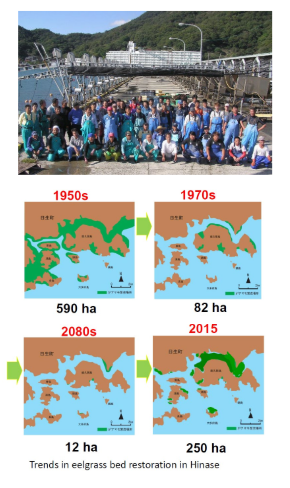
The Hinase area of Bizen City (hereinafter Bizen), facing the Seto Inland Sea, is an enclosed sea area consisting of an intricate coastline and 13 islands, and is part of the Setonaikai National Park. The area has long had highly productive sea areas, with small bottom tow net fishing, small set net (tsubo net) fishing, and oyster farming. Coastal development during the period of rapid economic growth led to a drastic decrease in eelgrass bed (from 590 ha in the 1950s to 5 ha in the 1980s); in addition, red tides and poor fisheries conditions caused a marked decrease in the number of fishers and their catches.
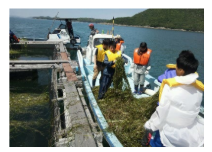
In response, the tsubo net fishers began eelgrass bed restoration activities (collecting and sowing eelgrass seeds) in 1985, and have continued for the past 35 years. In this eelgrass restoration project, through collaboration among the local government, the Fisheries Experiment Station, and researchers, a technique for improving the bottom sediment by spreading oyster shells was established for eelgrass restoration. As a result of this project, the eelgrass bed was restored to 250 hectares (in 2015), and the prefectural government promoted the restoration activities not only for the eelgrass bed but also for fishing grounds as a whole through development of a growth environment for eelgrass (the Marine Farm Concept). In addition, local companies and junior high schools participated in these activities, and the eelgrass bed restoration activities, involving the community and industry, have progressed.
LESSONS LEARNED
- As a result of the restoration of the eelgrass beds, the number of juvenile fish in the eelgrass beds and invertebrates on the leaves has increased, and the quality of the bottom sediment has improved by spreading oyster shells on the seabed. It indicates the potential of blue carbon ecosystem restoration and its co-benefits.
- The number of species and the amount of benthos, the material cycle, detritus food-web, and grazing food-web in this area are recovering. Fish that have not been caught in recent years (e.g., juveniles of Mottled spinefoot and green tail shrimp) are being caught again by tsubo net fishing in Hinase, indicating signs of a recovery in the fishery.
- “The Bizen City Satoyama Satoumi Branding Promotion Council with ICM” has been established and has started a project to brand the local processed products with the involvement of various stakeholders, which has raised the awareness of local industries and residents and mainstreamed biodiversity through Satoumi activities.
Conclusion
In the four case studies above, it was found that overall the Satoumi activities were effective in restoring water and sediment quality, recovering/maintaining ecosystems and biodiversity from degradation, and recovering/maintaining fisheries, although to different extents. Each of the four Satoumi activities has different conditions and contexts, but all of them are considered to be very important activities in pursuing the biodiversity targets.
POLICY IMPLICATIONS:
- Goals of Satoumi activities are clearly stated: Having clear goals for the activity in policies and within communities, and sharing them among the stakeholders helps ensure the continuity of motivation for activities. It also helps set measurable indicators and monitor the effect of the activities.
- Existence of a leader or key person: In all of the four Satoumi activities, there were such leaders or key persons, and the strength of leadership and passion towards the activity seemed to be related to its effectiveness. In addition, the existence of a person who coordinates the activities to make them run smoothly, and whether or not the activities are passed on to the next generation, are also considered important.
- Participation of stakeholders and inclusiveness: Involvement of various types of stakeholders (fishers, government, experts/researchers, educational institutions, private companies, citizens, and NGOs/NPOs) seemed to have a strong correlation with the success of Satoumi activities. The involvement of local government research institutes or academic experts in Satoumi activities was also considered to play an important role in promoting better Satoumi activities in line with scientific information. NGOs/NPOs also played an important role in all the activities.
- Bottom-up approach: The Satoumi activities seemed to be more successful and sustainable when started as voluntary activities by the local residents (mainly fishers), rather than when initiated by the government. The enthusiasm of local fishers, custodians of sea areas, attracted interest and involvement of the local governments and other stakeholders. The importance of sustainable funding and institutional support cannot be overstated, such as private sector participation, government subsidies and legal commitments.
- Scientific research and assessment: Involvement of experts is also important in establishing a mechanism to scientifically understand, monitor and verify the effectiveness of the activities and to maintain motivation to continue the activities.
Future Challenges
It was repeatedly pointed out that the effects of global warming and climate change are causing noticeable changes in marine ecosystems at the local level. The average seawater temperature is rising at a rate of more than 1°C/100 years at all sites, and changes in fish fauna, ocean current patterns and seasonal trends are being observed. Eelgrass, which has been restored through Satoumi activities, is also expected to be greatly affected by the deterioration caused by high water temperatures. The material cycle of the ocean is also expected to be affected by the decrease and change in nutrient concentrations due to rainfall caused by climate change. This will have an unprecedented impact on the biota and biodiversity, from plankton to large fish. In addition, the increase in carbon dioxide in seawater is expected to increase the acidification of seawater. The acidification of the ocean is expected to have a significant impact on corals, shellfish, and plankton, so that it is deeply concerning that significant impacts on oyster and pearl farming, which are important fishery resources, will occur. Furthermore, in recent years, microplastics have been pointed out as a major problem not only for ecosystems but also for the human body. In order to deal with these new issues, it is necessary to further consider what kind of Satoumi activities might be effective in the future, and also to put in place regulations and incentive mechanisms for eliminating the discharge of plastic wastes and promoting the recovery.
